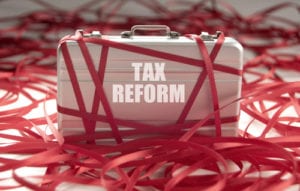By Robert J. McNeill, CPA
In the closing weeks of 2017, President Trump signed a tax reform bill called the Tax Cuts and Jobs Act. The 429-page law contains some pretty significant changes that may dramatically impact the multi-family real estate investment market.
Tax experts, pundits, and politicians alike are combing through the bill to see how it could impact their constituents. Like any bill of this size and scope, there is a lot in here that will both help and hinder multi-family owners. Below we take a look more closely at some of the ways the new law could possibly affect your business
Part II: The Bad and the (Almost) Ugly
Loss/Limitation of Itemized Deductions
While the Standard Deduction is great, you may not ever come close to what you lose in terms of itemized deduction on Schedule A. Here are some examples:
- Your state and local income taxes plus real estate taxes paid are now limited to $10,000 per year on Schedule A. This is a negative on taxpayers in high tax states like Massachusetts where that total can be sizable. But is seen as a small or non-factor in low-tax (or no-tax) states.
- Mortgage interest deduction is limited to acquisition indebtedness on the first $750,000, a reduction from the prior law of $1 million. Home equity loan interest is no longer deductible.
- Finally, personal property taxes are no longer deductible.
- Casualty losses are now only allowable if the loss is attributable to a presidentially declared disaster.
- All miscellaneous deduction previously subject to the 2% floor are repealed.
Elimination of DPAD and Rehabilitation Tax Credits
The existing Domestic Production Activity Deduction (DPAD) has been a great incentive for rehabbers, flippers, developers, and builders. Under the new law, you will only claim DPAD if you combine raw materials into an inventory item and then hold them out for sale.
The 10% Rehabilitation Tax Credit also was eliminated for pre-1936 historic buildings. The credit promotes development in run-down areas by providing a credit to investors who take the risk of fixing up derelict parts of cities and towns and who hold the properties for a number of years. The elimination of this credit is bad for both developers and those in communities most in need of rehab and development. The existing 20% credit for certified historic structures did, however, make it through unscathed.
The (Almost) Ugly
Like any proposal of this size and scope, there were a few things that were in initial drafts that would have been tough on multi-family owners, that fortunately didn’t make it into the approved bill.
Capital Gains Exemption Remains at 2 out of 5 Years
Currently, the IRC Section 121 allows you to exclude $250,000 ($500,000 if married) of capital gains on the sale of your primary residence, as long as you’ve lived in the property for the past two out of five years. At one point, the new proposal required owners to live in your primary residence for the past five of eight years in order to qualify for the gain exclusion. Fortunately, that was overturned in the final version of the bill and status quo remained.
Rental Income Not Subject to Self-Employment Tax

There was significant concern among the rental community that the wording of the proposed bill would have made rental income subject to an additional 15.3% self-employment tax. The proposed re-writing of the bill would have classified rental income as “net earnings from self-employment” if you were a real estate professional; you “Materially participate in your rental activities”; or if you invest in short-term rentals.
Fortunately, this did not make it through the final wording but is worth looking out for in future tax bills.
Private Activity Bonds (PAB) Used in Constructing Affordable Housing Remained Deductible and The Low-Income Housing Tax Credit Remains Intact
An earlier version of the Republicans’ tax bill could have gutted the new affordable housing market, but the final version kept most of the existing provisions in-tact.
Tax-exempt private activity bonds (PABs) are issued by state or local governments and loaned to private companies to finance qualified projects. The bonds are most commonly used for the construction of affordable multifamily housing and estimates indicate that more half of new affordable housing construction is funded at least partially with PABs.
Likewise, the Low-Income Housing Tax Credit program, known as LIHTC remained largely unchanged. It is responsible for 90 percent of affordable rental units built across the country so eliminating it could have had a massive impact on new construction.
Depreciation Period Remained Unchanged
One of the key parts of the Tax Cuts and Jobs Act was an attempt to streamline the depreciation of leasehold improvements by reducing the types of qualified improvement property. Unfortunately, a poorly worded section of the initial bill might have actually done just the opposite. Fortunately, this did not make the final cut and the depreciation period retained at 39, 27.5, and 15 for non-residential, residential, and improvements, respectively.
Click here to read “Part I: The Good”
About the Author

Bob McNeill is full service Certified Public Accountant and small business consultant. He services a wide variety of clients ranging from individuals to medium-sized corporations, partnerships, limited liability companies, and sole proprietorships. Bob specializes in income and estate tax planning and preparation, retirement planning, business consulting, and personal financial planning including education needs. You can reach him directly at (781) 224-9900 or at www.McNeillCPA.com


